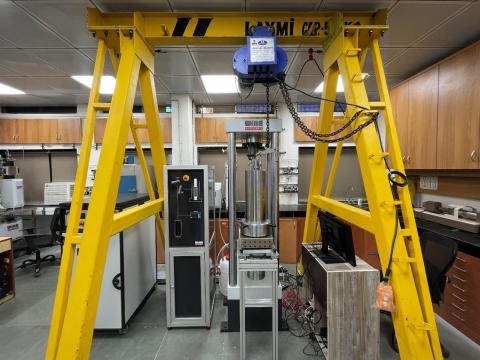
External users: registration to be carried out only through I-STEM portal
Additional information about sample and analysis details should be filled in the pdf form provided in the I-STEM portal under “DOWNLOAD CSRF”
Internal users (IITB): registration to be carried out only through DRONA portal
Additional information about sample and analysis details should be filled in the pdf form provided here.
.
Category
- Material Characterization » Mechanical Characterisation
Booking Details
Facility Management Team and Location
Facility Features, Working Principle and Specifications
Facility Description
The rock triaxial facility at the Department of Earth Sciences, IIT Bombay has undergone significant upgrades to enhance its research capabilities. High-pressure platens have been added, allowing for specimen testing at diameters of 38mm and 25.4mm. The upgraded facility now includes the capability to measure ultrasonic transmission velocities for both P-wave and S-wave, improving data collection on rock properties. A temperature control system has been incorporated, enabling triaxial testing at temperatures up to 100°C, which facilitates thermal-mechanical experiments. The addition of a syringe pump further enhances the setup, allowing for precise gas permeability measurements during testing. These enhancements provide a comprehensive approach to studying rock behavior under varied stress, temperature, and pressure conditions. The facility’s new features support a broader range of research, particularly in understanding rock deformation and permeability in complex environments. The integration of ultrasonic velocity measurements aids in non-destructive monitoring of sample integrity during tests.
A rock triaxial machine is an advanced laboratory instrument used to determine the mechanical properties of rock samples under controlled stress conditions. It is widely used in geotechnical engineering, rock mechanics, and petroleum reservoir studies to analyze rock strength, deformation behavior, and failure characteristics under different confining pressures. The triaxial test involves placing a cylindrical rock specimen (typically with a length-to-diameter ratio of 2:1) inside a pressure chamber. The specimen is subjected to three principal stresses:
Confining Pressure: Applied uniformly around the sample using hydraulic fluid or gas. This simulates in-situ stress conditions at depth.
Axial Stress: Applied vertically through a loading piston to induce failure.
Radial Stress: In most cases, this equals the confining pressure.
The machine applies confining pressure first, and then axial stress is gradually increased until the rock fails. The stress-strain response is recorded using sensors for axial displacement, radial deformation, and pore pressure (if applicable). The test provides key mechanical parameters, including:
Uniaxial Compressive Strength (UCS): When the test is performed without confining pressure.
Peak Strength and Failure Envelope: Determined by conducting tests at different confining pressures.
Young’s Modulus & Poisson’s Ratio: Derived from stress-strain curves.
Cohesion and Friction Angle: Obtained from the Mohr-Coulomb failure criterion.
Maximum cell pressure: 70MPa
Maximum operational temperature: 100°C
Maximum Ultrasonic velocity measure: 1MHz
Flow accuracy of Syringe pump: 0.0002ml/min
Sample Preparation, User Instructions and Precautionary Measures
Cylindrical core sample (50mm Diameter and 100 mm Height, 38mm Diameter and 76mm Height, 25.4mm Diameter and 50.8mm Height)
Charges for Analytical Services in Different Categories
Category | Rock Triaxial Test (1 set comprising 3 Samples) |
IITB TAs on specific instruments | 10000 |
IIT Bombay | 20000 |
Other Academic Institutes | 40000 + 18% GST |
National labs | 50000 + 18% GST |
Industries | 80000 + 18% GST |
Start-up (SINE incubation) | 50000 + 18% GST |
Monash IIT B | 20000 + 18% GST |
SAARCS countries & African countries (Low-Income Countries)
| 50000 (Academic) |
80000 (Industries) | |
For Other countries
| 80000 (Academic) |
160000 (Industries) |
Applications
Reservoir Engineering
Energy Resource Management
Environmental Geosciences
Civil Engineering
Sample Details
CO2, N2
